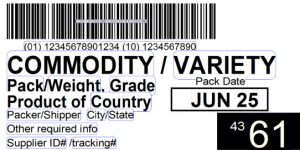Field to Fork Tracking with PTI Compatible Labels and Pallet Tags
 The latest mobile and on-site technology brings tremendous efficiencies to the Produce Traceability Initiative (PTI) process for “field to fork” tracking. PTI protects our food chain right to our dinner tables, and quickly identifies the location of any tainted produce in order to pull the product from your grocer’s shelves, inform customers and move towards fixing the underlying source of the problem.
The latest mobile and on-site technology brings tremendous efficiencies to the Produce Traceability Initiative (PTI) process for “field to fork” tracking. PTI protects our food chain right to our dinner tables, and quickly identifies the location of any tainted produce in order to pull the product from your grocer’s shelves, inform customers and move towards fixing the underlying source of the problem.
Software solutions integrate to back office ERP (Enterprise Resource Planning) databases and maintain the integrity of the chain of custody from grower to distributor to retailer.
Today, I am going to focus on how to print PTI labels and pallet tags easily and without disruption at the grower level. The best solutions offer a platform that fits your workflow, whether it is shed pack, line pack, or field pack.
How to Determine the Proper Label Adhesive and Material Choice
Different products and harvest processes will determine the proper label adhesive and material choice. Field packed produce might go into Styrofoam containers, standard boxes, waxed boxes or RPC’s (Reusable Plastic Containers). Cooling processes vary as well, ranging from forced air, hydro cooling, or icing.
Thermal label printers are typically used for PTI and other types of labels. Thermal printers will either be Direct Transfer or Thermal Transfer and both methods utilize a thermal print head that applies heat to the surface being marked. Thermal Transfer printing uses a heated ribbon, while no ribbon is used in Direct Thermal printing as the image is created directly on the label material.
What to Know About the PTI Barcode?
While both Direct Thermal and Thermal Transfer approaches are suitable for PTI barcode printing, there are a few considerations:
- Direct Thermal is a simpler design (no ribbon) making thermal printers durable, easy to use and less costly to operate. Most mobile printers are Direct Thermal.
- Thermal Transfer, which melts the ink from the ribbon into the material, produces a higher quality and more durable image. A wider range of materials is accepted, including paper, polyester, and polypropylene.
Basic information needed on the labels and tags include, a GTIN or Global Trade Item Numbers as a barcode.
Along with the GTIN, the following information is included:
- GTIN, lot and packing date
- Product type and description
- Product weight and packer identification
- Supplier and tracking ID numbers
It is recommended that labels be field tested to verify the material holds up, the image quality is suitably maintained and the adhesive sticks throughout the shipping process.
Where to Turn for Help in Printing PTI Compatible Labels and Pallet Tags?
We will all be safer and more confident in our food supply with PTI, but if you are wondering where to turn for help in finding your appropriate solutions, please feel free to reach out to us HERE with any questions you might have.


